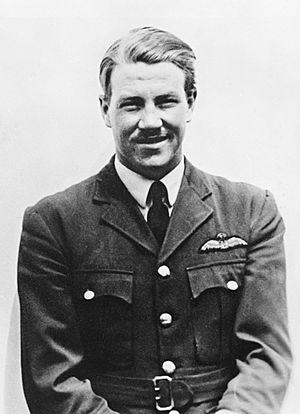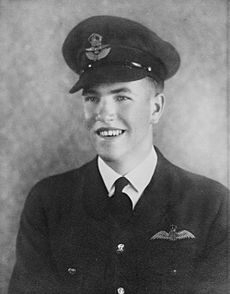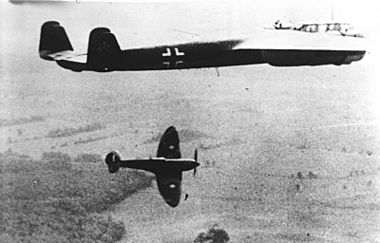Paterson Clarence Hughes facts for kids
Quick facts for kids
Paterson Clarence Hughes
|
|
|---|---|

Pat Hughes, 1940
|
|
| Born | 19 September 1917 Cooma, New South Wales, Australia |
| Died | 7 September 1940 (aged 22) Sundridge, Kent, England |
| Allegiance | Australia United Kingdom |
| Service/ |
Royal Australian Air Force (1936–1937) Royal Air Force (1937–1940) |
| Years of service | 1936–1940 |
| Rank | Flight Lieutenant |
| Service number | 39461 (RAF) |
| Unit | No. 64 Squadron RAF (1937–1939) No. 234 Squadron RAF (1939–1940) |
| Battles/wars | World War II
|
| Awards | Distinguished Flying Cross |
Paterson Clarence Hughes, also known as Pat, was a brave Australian fighter pilot during World War II. He was born on September 19, 1917, and sadly died on September 7, 1940. He served with the Royal Air Force (RAF) and became known as a "flying ace." This means he shot down many enemy aircraft.
During the famous Battle of Britain, Pat Hughes was credited with shooting down seventeen enemy planes. This made him the Australian pilot with the most victories in that battle. He was also one of the top three Australian pilots with the most victories during the entire war. He received the Distinguished Flying Cross (DFC) for his bravery.
Contents
Early Life and Joining the Air Force
Paterson Clarence Hughes was born in a small town called Numeralla, near Cooma, New South Wales, Australia. This was on September 19, 1917. He was one of twelve children in his family. His father was a teacher and also enjoyed writing for newspapers. Pat shared his father's love for books. He also loved the beautiful mountains and landscapes around his home.
Pat went to school in Cooma until he was twelve. Then, his family moved to Sydney. He went to Petersham Boys' School and was a good student. He enjoyed sports and building model airplanes. After school, he worked at a jewelry store. On January 20, 1936, he joined the Royal Australian Air Force (RAAF). He had also been accepted into the Navy, but he chose the Air Force.
He trained as a pilot at RAAF Point Cook near Melbourne. He learned to fly different types of planes. Pat was known for being a bit of a prankster. He loved flying and felt very happy during his first solo flight. After he finished his training in December 1936, he decided to join the Royal Air Force (RAF) in the United Kingdom. He sailed there in January 1937, hoping to do something special.
Early Days in the RAF
On March 20, 1937, Pat Hughes officially joined the RAF as a pilot officer. He kept his dark-blue Australian uniform instead of switching to the lighter RAF one. He continued his flight training in England. In July, he became a fighter pilot with No. 64 Squadron RAF. This squadron flew Hawker Demon planes and later Bristol Blenheim fighters.
In May 1938, his squadron moved to a new base. Pat was promoted to flying officer in November. His squadron then started using twin-engined Bristol Blenheim fighters.
In November 1939, Pat was promoted again to acting flight lieutenant. He became a leader in a new squadron, No. 234 Squadron RAF. This was after World War II had started. His new squadron began flying Supermarine Spitfires in March 1940. Pat was very experienced and helped train the other pilots to fly the Spitfires. He even had a pet Airedale Terrier dog named Flying Officer Butch, who sometimes flew with him!
Pat also met Kathleen ("Kay") Brodrick around this time. In June, his squadron moved to a new base in south-west England.
Fighting in the Battle of Britain
The Battle of Britain began in July 1940. Pat Hughes and his squadron quickly got into action. On July 8, he and two other Spitfires shot down a German Junkers Ju 88 bomber near Land's End. They shot down another one on July 28.
On August 1, Pat was sent to help set up another squadron. On the same day, he married Kay Brodrick. Only a few strangers were there, and none of his squadron friends could make it. Pat's squadron then moved to a new airfield called RAF Middle Wallop on August 14. Soon after they arrived, the German air force (called the Luftwaffe) bombed the airfield. Luckily, Pat's Spitfires were not damaged.
After moving to Middle Wallop, Pat started shooting down many German fighters. On August 15, he claimed two victories over Messerschmitt Bf 110s. He had two more victories on August 16, 18, and 26. All six of these planes were Messerschmitt Bf 109s, shot down near the Isle of Wight.
Pat was known for flying very close to enemy planes before he fired. He would get as close as three Spitfire lengths away! He also liked to attack enemy planes head-on. On August 16, he had a close call. After shooting down two planes, another German fighter shot at his plane from behind. Pat managed to escape. That evening, he joked with his wife, "In case of accidents make sure you marry again."
On September 3, Pat was officially promoted to flight lieutenant. He claimed three more enemy planes on September 4. He then shot down two more on September 5, and one more on September 6. One of his victories on September 5 might have been a famous German pilot named Franz von Werra, who was later captured. Pat and another pilot, Bob Doe, were responsible for half of their squadron's victories during this time.
Pat Hughes was killed in action on the evening of September 7, 1940. He was attacking a German Dornier Do 17 bomber that was part of a big attack on London. His Spitfire crashed in a field in Kent. It seems he tried to parachute out, but it did not open. His body was found near his plane. The German bomber also crashed.
No one knows exactly how Pat died, but his close-range flying style likely played a part. Many people believe his Spitfire was hit by flying pieces from the German bomber he had just shot down. It's also possible he accidentally crashed into the bomber. Some people on the ground even thought he crashed into the bomber on purpose. Four days after his death, his squadron moved to a quieter area.
Pat Hughes' Legacy
Pat Hughes was the top-scoring Australian "flying ace" of the Battle of Britain. He was one of fourteen Australian fighter pilots who died during the battle. People remember him as a great inspiration and leader for his squadron. He is officially credited with seventeen victories. This places him among the top ten Allied aces of the Battle of Britain. He is also among the three highest-scoring Australians of World War II.
His wife, Kay Hughes, was very sad after his death. She had only been married to him for five weeks. Pat's dog, Flying Officer Butch, ran away on the day Pat died and was never seen again. Pat was buried in a churchyard in England. Kay later drove ambulances to help with the war effort. Kay passed away in 1983, and her ashes were buried with Pat.
Pat Hughes was given the Distinguished Flying Cross (DFC) after he died. This was for his great skill and bravery in attacking the enemy. Kay received the medal at Buckingham Palace in 1942.
In Australia, there are memorials to Pat Hughes in Kiama and Cooma. His name is also on the Battle of Britain Roll of Honour in Westminster Abbey in London. The Australian War Memorial in Canberra also has his DFC medal and other service medals. In 2005, a plaque was placed in his honor at the spot where he fell in England. Another memorial stone was unveiled in 2008. Pat Hughes is remembered as a hero who helped defend Britain during a very important time.
Combat Record
| No. | Date | Flying | Foe | Result | Location |
|---|---|---|---|---|---|
| 1 | 8 July 1940 | Spitfire | Junkers Ju 88 | Destroyed (shared) | SE Lands End |
| – | 27 July 1940 | Spitfire | Junkers Ju 88 | Damaged (shared) | SE Lands End |
| 2 | 28 July 1940 | Spitfire | Junkers Ju 88 | Destroyed (shared) | SE Plymouth |
| 3 | 15 August 1940 | Spitfire | Messerschmitt Bf 110 | Destroyed | Middle Wallop – Isle of Wight |
| 4 | 15 August 1940 | Spitfire | Messerschmitt Bf 110 | Destroyed (shared) | SW Swanage |
| 5 | 16 August 1940 | Spitfire | Messerschmitt Bf 109E | Destroyed | Isle of Wight |
| 6 | 16 August 1940 | Spitfire | Messerschmitt Bf 109E | Destroyed | Isle of Wight |
| 7 | 18 August 1940 | Spitfire | Messerschmitt Bf 109E | Destroyed | Isle of Wight |
| 8 | 18 August 1940 | Spitfire | Messerschmitt Bf 109E | Destroyed | Isle of Wight |
| 9 | 26 August 1940 | Spitfire | Messerschmitt Bf 109E | Destroyed | Isle of Wight |
| 10 | 26 August 1940 | Spitfire | Messerschmitt Bf 109E | Destroyed | Isle of Wight |
| 11 | 4 September 1940 | Spitfire | Messerschmitt Bf 110 | Destroyed | Haslemere–Brighton |
| 12 | 4 September 1940 | Spitfire | Messerschmitt Bf 110 | Destroyed | Haslemere–Brighton |
| 13 | 4 September 1940 | Spitfire | Messerschmitt Bf 110 | Destroyed | Haslemere–Brighton |
| 14 | 5 September 1940 | Spitfire | Messerschmitt Bf 109E | Destroyed | Eastchurch |
| 15 | 5 September 1940 | Spitfire | Messerschmitt Bf 109E | Destroyed | S Manston |
| 16 | 6 September 1940 | Spitfire | Messerschmitt Bf 109E | Destroyed | Dover |
| – | 6 September 1940 | Spitfire | Messerschmitt Bf 109E | Probable | Dover |
| 17 | 7 September 1940 | Spitfire | Dornier Do 17 | Destroyed | London–Brighton |



